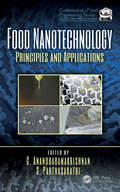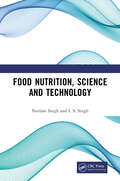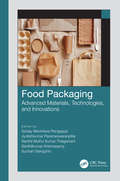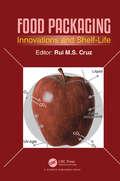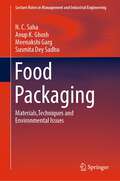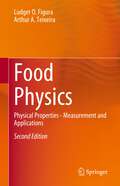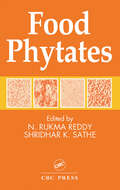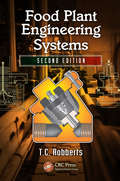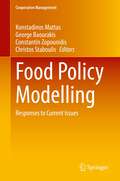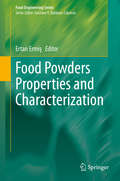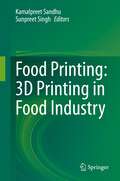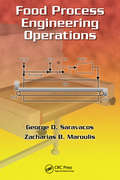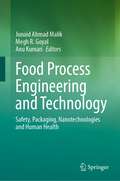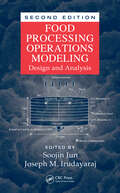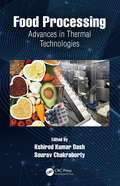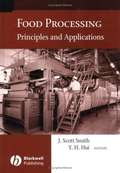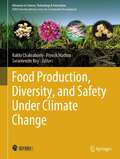- Table View
- List View
Food Nanotechnology: Principles and Applications (Contemporary Food Engineering)
by C. Anandharamakrishnan S. ParthasarathiNanotechnology offers great potential to revolutionize conventional food science and the food industry. The use of nanotechnology in the food industry promises improved taste, flavor, color, texture, and consistency of foodstuffs and increased absorption and bioavailability of nutraceuticals. Food Nanotechnology: Principles and Applications examines the current state of nanoscale phenomena and processes, benefits and risks of nanotechnology. This work contains 18 chapters particularly focused on the design, production, and utilization of nanoparticles, with specific applications for the food industry. Through several studies, it has been proven that nanotechnology can offer distinct advantages over conventional methods in terms of functionality, targeted delivery of food bioactive compounds, improved food quality characteristics like texture, taste, sensory attributes and improved stability in the gastrointestinal tract, and controlled release profiles. Features Offers clear and concise coverage on application of nanotechnology in nutrient delivery, food packaging, and pathogen/pesticide detection Addresses both the technological aspects of delivering nano-based food products and the societal implications that affect take-up Covers broad range of topics including nanoemulsification, electrospraying, nanocomposites, plasma processing, and nanosensors Discusses different formulation and preparation methods for loading food bioactive compounds Exploratory in nature, this book presents the latest of such data on all aspects of applications of nanotechnology in food systems. With its practical focus on the fabrication and application of nanotechnology in food, this book is a valuable resource for students, researchers, food process engineers.
Food Network Magazine The Big, Fun Kids Baking Book Free 14-Recipe Sampler!
by Food Network Magazine Maile CarpenterCalling all junior bakers! Check out this special selection of 14 recipes from the first-ever baking book for kids from the editors of Food Network Magazine—including Carrot-Coconut Muffins,Lemon-Raspberry Quick Bread, Peanut Butter Cup Brownies, Butterscotch Blondies, Snack-Attack Cookies with Bacon and S&’mores Cake. Then if you want more, look for all 110 recipes in The Big, Fun Kids Baking Book. It also includes food trivia, tips, food crafts, and other fun activities.
Food Network Magazine The Big, Fun Kids Baking Book: 110+ Recipes for Young Bakers (Food Network Magazine's Kids Cookbooks #2)
by Food Network Magazine Maile CarpenterThe ultimate kids' cookbook for beginner bakers, from the editors of America's #1 food magazine and bestselling authors of The Big, Fun Kids Cookbook.This collection is packed with tons of recipes for easy sweets and treats, designed with young cooks in mind and triple tested by the chefs in Food Network Kitchen. Kids will get all the info they need to make their favorite desserts: muffins and quick breads, brownies and bars, cookies, cupcakes, sheet cakes, and more. The recipes are simple to follow and totally foolproof, and each one comes with a color photo and pro tips to help junior chefs get started in the kitchen. Inside you'll find: • 110+ delicious recipes • Fun food trivia • A visual recipe index with a photo of every recipe • Choose-your-own adventure recipes (such as design-your-own Whoopie Pies and Banana Bread) • Crowd-pleasers like Red Velvet Brownies, Pumpkin Spice Chocolate Chip Cookies, Mini PB & Chocolate Cupcakes, Chocolate Candy Bar Layer Cake, and more! • Fun food crafts such as cookie puzzle pieces and DIY sprinkles • Amazing fake-out cakes including spaghetti and meatballs, a taco, and a pineapple • Bonus food-themed activity pages with word scrambles, spot-the-difference photo games, and more • Lay-flat binding and a heavy paper stock that will stand up to frequent use
Food Nutrition, Science and Technology
by Neelam Singh I. S. SinghThis book explores the nexus of science, technology and nutrition that shapes the way we produce, consume and experience food. It discusses the innovations and principles driving the future of nourishment. The latest scientific information on food nutrition, science and technology are compiled for a better understanding of each division. Print edition not for sale in South Asia (India, Sri Lanka, Nepal, Bangladesh, Pakistan and Bhutan)
Food Packaging: Advanced Materials, Technologies, and Innovations
by Sanjay Mavinkere Rangappa, Jyotishkumar Parameswaranpillai, Senthil Muthu Kumar Thiagamani, Senthilkumar Krishnasamy and Suchart SiengchinFood Packaging: Advanced Materials, Technologies, and Innovations is a one-stop reference for packaging materials researchers working across various industries. With chapters written by leading international researchers from industry, academia, government, and private research institutions, this book offers a broad view of important developments in food packaging. Presents an extensive survey of food packaging materials and modern technologies Demonstrates the potential of various materials for use in demanding applications Discusses the use of polymers, composites, nanotechnology, hybrid materials, coatings, wood-based, and other materials in packaging Describes biodegradable packaging, antimicrobial studies, and environmental issues related to packaging materials Offers current status, trends, opportunities, and future directions Aimed at advanced students, research scholars, and professionals in food packaging development, this application-oriented book will help expand the reader’s knowledge of advanced materials and their use of innovation in food packaging.
Food Packaging: Innovations and Shelf-Life
by Rui M. S. Da CruzFood Packaging: Innovations and Shelf-life covers recently investigated developments in food packaging and their influence in food quality preservation, shelf-life extension, and simulation techniques. Additionally, the book discusses the environmental impact and sustainable solutions of food packaging. This book is divided into seven chapters, written by worldwide experts. The book is an ideal reference source for university students, food engineers and researchers from R&D laboratories working in the area of food science and technology. Professionals from institutions related to food packaging.
Food Packaging: Materials,Techniques and Environmental Issues (Lecture Notes in Management and Industrial Engineering)
by Anup K. Ghosh N. C. Saha Meenakshi Garg Susmita Dey SadhuThis comprehensive and authoritative book aims to encompass the best and current practices in the field of contemporary food packaging. It covers various aspects of packaging, including challenges and their solutions, innovations, and environmental concerns. Written by experts working in the field, the content is supported by technical/statistical data, practical examples, case studies, and real-life experiences of academicians and professionals working in the area of food packaging. The book covers challenges in food packaging, systems and materials for packaging, packaging design requirements of the food industry, technology machinery and system, printing and graphics, testing and regulatory aspects, advanced and smart packaging, distribution and logistics in a globalized environment, and sustainable and green packaging. This book will be useful for Packaging Technologists, food scientists, material scientists, policy makers, students, and researchers.
Food Packaging: The Smarter Way
by Ashutosh Kumar ShuklaThis book reviews the science and technology of food packaging and covers the potential innovations in the food packaging sector. At the same time, it highlights the issues and prospects for linking the laboratory research to the market. In addition to typical packaging requirements such as food quality, shelf life, protection, communication, and marketing, the book emphasizes the need for novel packaging materials, including biodegradable packaging for a variety of food products. A wide range of food products has been kept in focus and includes animal-based food products such as dairy products and sea foods. The book presents the next level of packaging solutions i.e., smart packaging with the applications of potential tools such as intelligent and active packaging, and includes the latest research on emerging digital technologies for packaging development, assessment, and acceptability. It further highlights the strategies including blends, reinforcing agents, cold plasma, UV light applications, chemical, and enzymatic methods and explores the new opportunities leading to improvement in the packaging performance. Smart freshness indicator applications, including gas and time-temperature indicators for quality and safety of packaged products, have been covered in detail. The book also includes the functional characteristics of edible films and coatings, including their bioactive characteristics. Finally the book presents the rules and regulation related to packaging.
Food Physics: Physical Properties - Measurement and Applications
by Arthur A. Teixeira Ludger O. FiguraThis is the first textbook in this field of increasing importance for the food and cosmetics industries. It is indispensable for future students of food technology and food chemistry as well as for engineers, technologists and technicians in the food industries. It describes the principles of food physics starting with the very basics – and focuses on the needs of practitioners without omitting important basic principles. It will be indispensable for future students of food technology and food chemistry as well as for engineers, technologists and technicians in the food industries. Food Physics deals with the physical properties of food, food ingredients and their measurement.
Food Phytates
by N. Rukma Reddy Shridhar K. SatheFood Phytates takes a new look at phytates, including their potential health benefits. It includes the latest information on the beneficial heath effects of phytates, the influence of phytates in disease prevention, the potential use of phytate as an antioxidant in foods, and phytase expression in transgenic plants. In 14 chapters, leading research
Food Plant Engineering Systems
by Theunis Christoffel RobbertsThe component parts of a manufacturing system are important. Without peripherals and services such as pumps, boilers, power transmission, water treatment, waste disposal, and efficient lighting, the system will collapse. Food Plant Engineering Systems, Second Edition fills the need for a reference dealing with the bits and pieces that keep systems
Food Plants of the Sonoran Desert
by Wendy C. HodgsonThe seemingly inhospitable Sonoran Desert has provided sustenance to indigenous peoples for centuries. Although it is to all appearances a land bereft of useful plants, fully one-fifth of the desert's flora are edible. This volume presents information on nearly 540 edible plants used by people of more than fifty traditional cultures of the Sonoran Desert and peripheral areas. Drawing on thirty years of research, Wendy Hodgson has synthesized the widely scattered literature and added her own experiences to create an exhaustive catalog of desert plants and their many and varied uses. Food Plants of the Sonoran Desert includes not only plants such as gourds and legumes but also unexpected food sources such as palms, lilies, and cattails, all of which provided nutrition to desert peoples. Each species entry lists recorded names and describes indigenous uses, which often include nonfood therapeutic and commodity applications. The agave, for example, is cited for its use as food and for alcoholic and nonalcoholic beverages, syrup, fiber, cordage, clothing, sandals, nets, blankets, lances, fire hearths, musical instruments, hedgerows, soap, and medicine, and for ceremonial purposes. The agave entry includes information on harvesting, roasting, and consumption-and on distinguishing between edible and inedible varieties. No other source provides such a vast amount of information on traditional plant uses for this region. Written to be easily accessible to general readers, the book is an invaluable compendium for anyone interested in the desert's hidden bounty.
Food Policy Modelling: Responses to Current Issues (Cooperative Management)
by Constantin Zopounidis Konstadinos Mattas George Baourakis Christos StaboulisIn the present economic, political, societal and environmental landscape, which is dominated by the COVID-19 pandemic, the emergence of challenges and issues that demand immediate and urgent responses is more intense than ever. Policymakers, international organizations, governmental and non-governmental institutions around the globe are seeking effective and sustainable policies, as they try to tackle far-reaching issues that affect all aspects of the economy and agriculture, including the food sector. In this context, this book presents new modelling approaches and their application to complex problems in the agro-food chain in order to address today’s pressing food policy issues. The respective chapters showcase national and regional studies on sustainable communities, rural environments and ecosystems. Taken together, they offer a valuable reference guide for scholars and practitioners alike.”
Food Powders Properties and Characterization (Food Engineering Series)
by Ertan ErmişFood powders are an increasingly important aspect of processed food worldwide. Essential factors such as ease of storage and transport and usage convenience have greatly benefited the food industry and promise further advancements in processing techniques. Food powders can be stored for a longer period of time than other food products, making them essential for food supply in many regions of the world. There have been numerous research works on food powders properties and characterization, but there has not been an updated comprehensive review in this field. Food Powders Properties and Characterization is designed as an essential reference for individuals in the food industry and academia seeking a singular source that covers most of the basic aspects of food powders. With chapters focusing on the general properties of food powders, characterization of particle and bulk properties, adhesion and surface properties, this text presents comprehensive and fully up to date coverage of this challenging and important field.
Food Printing: 3D Printing in Food Industry
by Sunpreet Singh Kamalpreet SandhuThis book provides a comprehensive overview of the technical notes, research designs, literature, and 3DP (three-dimensional printing) technology applications for effective food printing. It provides a multidisciplinary coverage of 3D food printing in different food sectors. Recent advancements in manufacturing processes have led food industries to create innovations to stay competitive in the market. 3D food printing incorporates 3DP digital gastronomy strategies to manufacture food products with consistency in shape, color, flavor, texture, and even nutrition. Thus, by controlling the number of materials and the quality of nutrients, food items can be manufactured and handled to fulfill their particular requirements. For food printing, both proprietary structures and self-developed frameworks are used from open sources. Similar frameworks are re-engineered to reformulate administration, content creation, and user interface. For example, three printing medium types, natural printable products, non-printable synthetic food products, and alternative ingredients as well as two recipe forms (i.e., element-based recipes and regular recipes) are used for customized food production. The authors address that open 3D technology for food printing and food processing technology are theoretically correlated with food printing. The book will help industrial designers, nutrition professionals, dieticians, manufacturing enterprises, and young researchers in food technology, material science, and mechanical engineering understand the latest advances in 3DP technology in food industries.
Food Process Engineering Operations (Contemporary Food Engineering)
by George D. Saravacos Zacharias B. MaroulisA unique and interdisciplinary field, food processing must meet basic process engineering considerations such as material and energy balances, as well as the more specialized requirements of food acceptance, human nutrition, and food safety. Food engineering, therefore, is a field of major concern to university departments of food science, and chem
Food Process Engineering and Technology: Safety, Packaging, Nanotechnologies and Human Health
by Megh R. Goyal Junaid Ahmad Malik Anu KumariThis book focuses on novel technologies related to food processing technology and engineering. It also focuses on food safety, quality and management, the scope of the Internet of Things (IoT) in food processing and its management, bioengineering tools for crop improvement in agriculture, recent innovations in food packaging, nanotechnology in food processing, and the nutritional health benefits of food. 3D printed food, an interesting and increasingly popular concept among the public today, is a meal prepared through an automated additive process using 3D food printers. This book is a ready reference for food researchers, students, and industry professionals. The book updates the current scenario of food processing technology and engineering for readers from agriculture and its allied fields including students and researchers of food science and technology, dairy science and technology, packaging industry, people working in food safety organisations, and researchers in the field of nanotechnology.
Food Processing Operations Modeling: Design and Analysis, Second Edition (500 Tips)
by Soojin Jun Joseph M. IrudayarajThe second edition of Food Processing Operations Modeling focuses on novel processing technologies relevant to food safety and quality as well as new commercialized computational fluid dynamics software to model complex food processing systems. Addressing engineering principles and backed by numerical approaches, this edition features new chapters that provide in-depth coverage of high-pressure processing design and analysis, pulsed electric field processing and modeling, radio frequency heating, ozone treatment, and UV pasteurization of food materials. The text updates new information on infrared heating of biological materials as well as modeling electrical resistance heating of foods.
Food Processing: Advances in Non-Thermal Technologies
by Kshirod Kumar Dash Sourav ChakrabortyNon-thermal operations in food processing are an alternative to thermal operations and similarly aimed at retaining the quality and organoleptic properties of food products. This volume covers different non-thermal processing technologies such as high-pressure processing, ultrasound, ohmic heating, pulse electric field, pulse light, membrane processing, cryogenic freezing, nanofiltration, and cold plasma processing technologies. The book focuses both on fundamentals and on recent advances in non-thermal food processing technologies. It also provides information with the description and results of research into new emerging technologies for both the academy and industry. Key features: Presents engineering focus on non-thermal food processing technologies. Discusses sub-classification for recent trends and relevant industry information/examples. Different current research-oriented results are included as a key parameter. Covers high-pressure processing, pulse electric field, pulse light technology, irradiation, and ultrasonic techniques. Includes mathematical modeling and numerical simulations. Food Processing: Advances in Non-Thermal Technologies is aimed at graduate students, professionals in food engineering, food technology, and biological systems engineering.
Food Processing: Advances in Thermal Technologies
by Kshirod Kumar Dash Sourav ChakrabortyIn food processing, thermal operations are the most common and conventional methods for obtaining and treating different products. This book covers basics and advances in thermal processing of food. These include drying processes, evaporation, blanching, deep fat frying, crystallization, extraction, and ohmic heating, in terms of food engineering and process design aspect. It further describes theoretical aspects, the basics of rate kinetics, and their application for the analysis of food quality indices including practical-oriented issues related to food technology. Traditional and new extraction techniques are also covered. Key features: Presents engineering focus on thermal food processing technologies. Discusses sub-classification for recent trends and relevant industry information/examples. Different current research-oriented results are included as a key parameter. Covers advances in drying, evaporation, blanching, crystallization, and ohmic heating. Includes mathematical modeling and numerical simulations. Food Processing: Advances in Thermal Technologies is aimed at graduate students and professionals in food engineering, food technology, and biological systems engineering
Food Processing: Principles and Applications (3rd Edition)
by J. Scott Smith Y. H. HuiRenowned international academicians and food industry professionals have collaborated to create Food Processing: Principles and Applications. This practical, fully illustrated resource examines the principles of food processing and demonstrates their application by describing the stages and operations for manufacturing different categories of basic food products. Ideal as an undergraduate text, Food Processing stands apart in three ways: The expertise of the contributing authors is unparalleled among food processing texts today. The text is written mostly by non-engineers for other non-engineers and is therefore user-friendly and easy to read. It is one of the rare texts to use commodity manufacturing to illustrate the principles of food processing. As a hands-on guide to the essential processing principles and their application, this book serves as a relevant primary or supplemental text for students of food science and as a valuable tool for food industry professionals.
Food Production, Diversity, and Safety Under Climate Change (Advances in Science, Technology & Innovation)
by Swarnendu Roy Piyush Mathur Rakhi ChakrabortyThis book presents a universal picture of the impact of climate change on food production, diversity, and concerns regarding food safety. The book also highlights the traditional and modern techniques for sustainably improving the production of food crops and their nutritional quality aligning with the “zero hunger” goal (Sustainable Development Goal 2) of the United Nations. The book holistically includes the contributions of scientists and academicians working in the fields of Food and Nutrition, Plant and Microbial Sciences, Agriculture, etc. The book also offers insights into the strategies adopted worldwide for ensuring food availability and safety, taking the aid of advanced technologies like climate-smart agriculture along with nanotechnology and artificial intelligence in the event of climate change. Above all, the book transpires the subject matter using illustrative figures and outlines and therefore will be an asset for the post-graduate students, researchers, and faculties.
Food Proteins and Their Applications (Food Science And Technology Ser. #80)
by Srinivasan DamodaranReviews the physiochemical properties of the main food proteins and explores the interdependency between the structure-function relationship of specific protein classes and the processing technologies applied to given foods. The book offers solutions to current problems related to the complexity of food composition, preparation and storage, and includes such topics as foams, emulsions, gelation by macromolecules, hydrolysis, microparticles/fat replacers, protein-based edible films, and extraction procedures.
Food Safety & Mycotoxins
by Aibo WuMycotoxins are increasingly attracting attention at thegovernmental, public and academic level worldwide, due to more frequent and serious contaminations of food and feedstuffs, which pose a serious threat to human health and animal production. This book reviews the latest research on mycotoxins that directly concern food safety, and especially focuses on detection technologies, risk assessment and control strategiescurrently being used in China. Gathering contributions from over 20 respected researchers, the book will benefit graduatestudents, researchers and management groups from various disciplines, including food science and technology, analytical chemistry, plant pathology, public health, etc.
Food Safety Engineering (Food Engineering Series)
by Hao Feng Ali Demirci Kathiravan KrishnamurthyFood Safety Engineering is the first reference work to provide up-to-date coverage of the advanced technologies and strategies for the engineering of safe foods. Researchers, laboratory staff and food industry professionals with an interest in food engineering safety will find a singular source containing all of the needed information required to understand this rapidly advancing topic. The text lays a solid foundation for solving microbial food safety problems, developing advanced thermal and non-thermal technologies, designing food safety preventive control processes and sustainable operation of the food safety preventive control processes. The first section of chapters presents a comprehensive overview of food microbiology from foodborne pathogens to detection methods. The next section focuses on preventative practices, detailing all of the major manufacturing processes assuring the safety of foods including Good Manufacturing Practices (GMP), Hazard Analysis and Critical Control Points (HACCP), Hazard Analysis and Risk-Based Preventive Controls (HARPC), food traceability, and recalls. Further sections provide insights into plant layout and equipment design, and maintenance. Modeling and process design are covered in depth. Conventional and novel preventive controls for food safety include the current and emerging food processing technologies. Further sections focus on such important aspects as aseptic packaging and post-packaging technologies. With its comprehensive scope of up-to-date technologies and manufacturing processes, this is a useful and first-of-its kind text for the next generation food safety engineering professionals.
